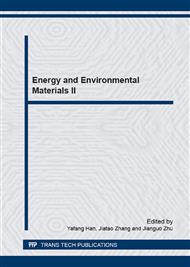p.384
p.389
p.392
p.398
p.404
p.411
p.418
p.425
p.430
Effects of Sr2+ Doping on the Luminescent Properties of CaTiO3: Pr3+
Abstract:
The perovskites red phosphors activated by Pr3+ were prepared via the combustion method, using citric acid as a fuel and complex agent. The samples were characterized by X-ray powder diffraction and fluorescence spectrophotometry respectively. The effects of calcination temperature and doping Sr2+ ion concentration on the phase compositions and luminescence properties were investigated. The CaTiO3: Pr3+ can be obtained with high purity and good crystallinity by the combustion method at different calcination temperatures (750 oC, 850 oC, 900 oC, 950 oC and 1000 oC) for 1 h. The sample obtained at 900 oC exhibits the maximum emission intensity. The crystal structure of the obtained Ca1-xSrxTiO3: Pr3+(x = 0, 0.1, 0.2, 0.3, 0.4, 0.5, and 0.6) changes from perovskite to calcium strontium titanate when x ≥ 0.3. The sample exhibits the maximum red emitting when x = 0.4.
Info:
Periodical:
Pages:
404-408
Citation:
Online since:
March 2015
Authors:
Keywords:
Price:
Сopyright:
© 2015 Trans Tech Publications Ltd. All Rights Reserved
Share:
Citation:


